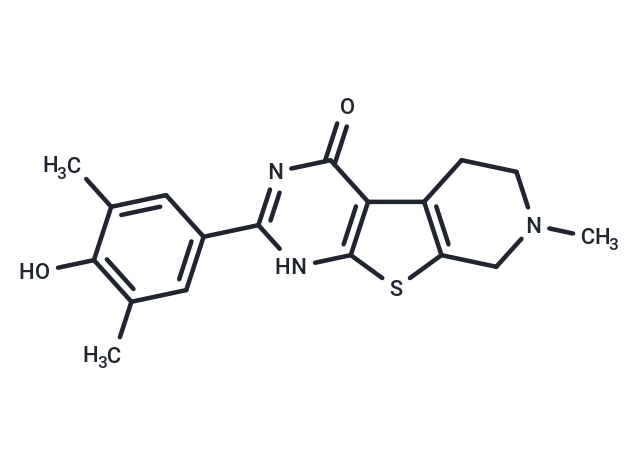Shopping Cart
- Remove All
 Your shopping cart is currently empty
Your shopping cart is currently empty

FL-411 (BRD4-IN-1) is a potent and selective BRD4 inhibitor with an IC50 of 0.43±0.09 μM for BRD4.

| Pack Size | Price | Availability | Quantity |
|---|---|---|---|
| 2 mg | $30 | In Stock | |
| 5 mg | $53 | In Stock | |
| 10 mg | $88 | In Stock | |
| 25 mg | $178 | In Stock | |
| 50 mg | $298 | In Stock | |
| 100 mg | $497 | In Stock | |
| 200 mg | $689 | In Stock | |
| 1 mL x 10 mM (in DMSO) | $59 | In Stock |
| Description | FL-411 (BRD4-IN-1) is a potent and selective BRD4 inhibitor with an IC50 of 0.43±0.09 μM for BRD4. |
| Targets&IC50 | BRD4:0.43 μM |
| In vitro | FL-411 is a selective BRD4 inhibitor. Its binding affinities were measured via TR-FRET against BRD2(1), BRD4(1), and BRD4(2) with IC50 values of 24.60±0.70 μM, 0.47±0.02 μM, and 0.93±0.05 μM, respectively. FL-411 demonstrates effective BRD4(1) inhibition (IC50=0.43±0.09 μM), antiproliferative activity in MCF-7 (IC50=1.62±0.06 μM) and MDA-MB-231 (IC50=3.27±0.14 μM) cells, as well as 42.29% autophagic activity in MCF-7 cells, with low toxicity against MCF10A cells. It induces ATG5-dependent autophagy-associated cell death (ACD) by disrupting the BRD4-AMPK interaction, subsequently activating the AMPK-mTOR-ULK1 autophagic pathway in breast cancer cells. |
| In vivo | To assess the anti-tumor efficacy of FL-411 in vivo, MCF-7 and MDA-MB-231 breast tumor xenograft models were employed, utilizing FL-411 doses of 25 mg/kg, 50 mg/kg, and 100 mg/kg. FL-411 demonstrated significant dose-dependent tumor growth inhibition in these models, with tumor growth inhibition ratios of 80% in MCF-7 and 76% in MDA-MB-231 models, along with a substantial reduction in tumor weights across all doses (p<0.001), without adversely affecting the body weight in treated groups. Further investigation into the mechanism behind FL-411’s effectiveness revealed a marked decrease in the proliferation marker Ki-67 (p<0.001) and an increase in autophagy, evidenced by elevated LC3 expression (p<0.001), indicating that FL-411's tumor suppression may involve reducing cell proliferation and enhancing autophagic cell death. |
| Cell Research | The MCF-7 and MDA-MB-231 cells are dispensed in 96-well flat bottom microtiter plates at a density of 5×104 cells/mL. After 24 h incubation, MCF-7 or MDA-MB-231 cells are treated with 1.5 and 3 μM FL-411, respectively. 3-MA (1 mM) is added 1 h before treated with FL-411. After treatment, cell viability is measured by the MTT assay. 5 mg/mL MTT is added to each well. After 4 h incubation, the medium is removed and 150 μL of DMSO is added to each well to dissolve the crystal formazan dye. Absorbance is measured at 570 nm on an enzyme-linked immunosorbent assay reader |
| Animal Research | Mice52 female nude mice (BALB/c, 6-8 weeks, 20-22 g) are injected subcutaneously with MCF-7 cells or MDA-MB-231 cells (5×106 cells/mouse), respectively. When the tumors reach 100 mm3 in volume, the mice are divided into four groups for each cell line. Three groups are treated with different doses of FL-411 (low dose, 25 mg/kg; median dose, 50 mg/kg; high dose, 100 mg/kg) once a day by intragastric administration for 24 or 27 days, whereas the control group is treated with vehicle control. During the treatment, the tumor volumes and body weight are measured every 3 days until the end of the study. At the end of treatment, all mice are sacrificed. The tumor tissues are harvested, weighed, and photographed. Then, the tumor tissues are frozen in liquid nitrogen or fixed in formalin immediately |
| Alias | FL411, FL 411, BRD4-IN-1 |
| Molecular Weight | 341.43 |
| Formula | C18H19N3O2S |
| Cas No. | 2118944-88-8 |
| Smiles | CN1CCc2c(C1)sc1[nH]c(nc(=O)c21)-c1cc(C)c(O)c(C)c1 |
| Relative Density. | 1.45 g/cm3 (Predicted) |
| Storage | Powder: -20°C for 3 years | In solvent: -80°C for 1 year | Shipping with blue ice. | |||||||||||||||||||||||||
| Solubility Information | DMSO: 8.57 mg/mL (25.1 mM), Sonication is recommended. | |||||||||||||||||||||||||
Solution Preparation Table | ||||||||||||||||||||||||||
DMSO
| ||||||||||||||||||||||||||

Copyright © 2015-2025 TargetMol Chemicals Inc. All Rights Reserved.